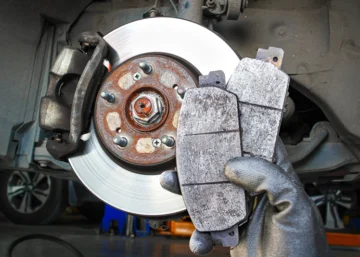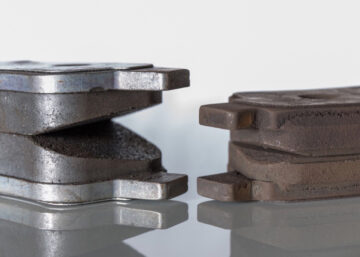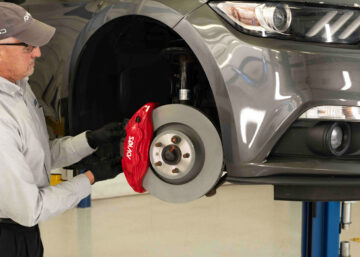
As a counter professional, you likely have customers inquiring daily about why they should purchase one brake pad over another. Our expert techs at ADVICS have compiled the following guide to help you with these conversations.
What is the Correlation Between Brake Pad Cost and Quality?
When considering the wide array of brake pad options in the market, discussing both cost and quality with your customers is essential. There is a direct correlation between cost and performance, and significant differences between “cheap” and “expensive” brake pads, primarily due to the variations in the raw materials and production methods used.
The raw materials not only determine the overall quality of the part, but also directly influence the performance of the brake pads. Understanding the customer’s driving conditions and budget is especially crucial when advising DIYers, given that brake pads play a critical role in the safety and driving characteristics of a vehicle.
While there’s no definite answer for how much a high-quality brake pad should cost, counter professionals like you are here to help educate customers on what’s best for their vehicle, based on their driving conditions and budget. Counter professionals should be able to explain the differences between OE-equivalent parts, such as ADVICS ultra-premium quality brake pads, which are built to ensure optimal safety and performance on the road, and “cheap” replacements.
What Are Brake Pads Made of and Why is it Important?
There is no question that brake pad composition significantly affects performance. Typically, brake pads fall into one of three categories:
- Ceramic/Non-Asbestos Organic
- Semi-Metallic
- Low Steel
Because the brake system plays such a critical role in vehicle safety, selecting the appropriate brake pad and material is essential. Finding the perfect fit for your customer’s vehicle can significantly enhance performance and extend the lifespan of their braking system.
Ceramic brakes are often used on passenger cars and light trucks that are typically daily drivers and are known for being very durable, long-lasting, quieter, and producing less dust. However, ceramic brake pads are usually the most expensive.
Semi-metallic (or often referred to as just “metallic”) brake pads contain approximately 50% steel fiber, and often a graphite lubricant as well as other durable resin material to complete manufacturing. Semi-metallic brake pads are typically selected for heavy duty trucks or vehicles that are often towing. They are also selected for performance vehicles that are driven on the street or performance driving events.
Low steel brake pads contain 10-30% steel fibers and softer metals. These brake pads are typically lower in price compared to semi-metallic brake pads but will wear faster due to the use of softer metals. Low steel brake pads align with semi-metallic brake pads with regards to vehicle applications.
Vehicle type, driving conditions and cost will be the determining factors in selecting what’s best for your customers.
Are Aftermarket Brake Pads the Same As OE?
While OE parts are custom-made for specific vehicles, rest assured that aftermarket brake pads can match or even exceed OE performance. The key difference between OE and aftermarket brake pads lies in materials, cost, and production methods. This creates a wide array of options to cater to a customer’s unique needs.
Concerns often arise over the relation of cost, quality, fit, and performance of an aftermarket product, though these variations are typically linked to differences in materials or production, rather than the actual quality of the part. Giving customers a clear understanding of the difference can instill confidence in their selection.
Do Brake Pads Come with Hardware?
When DIYers gear up to replace their brake pads, a common question arises: Do brake pads come with installation hardware? The answer to this question will vary depending on the brand or product that your customer chooses, although, in many cases, hardware is included.
Hardware that is typically included consists of abutment clips, caliper guide pins and anti-rattle clips.
While not entirely necessary, it is best practice to stress the importance of changing all hardware while performing a brake job, regardless of whether it is included in the kit. Doing so helps to ensure OE-level performance.
Do Rotors Need to Be Replaced with Brake Pads?
When DIYers are shopping for brake pads, it’s common for them to consider the status of their rotors, too. At ADVICS, we advise customers to replace brake rotors alongside brake pads.
While the wear and tear on pads and rotors may slightly differ, it’s generally safe to assume that if the brake pads need replacement, so do the rotors. However, the frequency or replacement varies based on wear and tear. Opting to replace pads and rotors simultaneously ensures optimal performance levels and stopping abilities. You can read more about the importance of rotor replacement here.
“Braking” It Down for Your Customers
Here at ADVICS, our goal is to keep counter professionals equipped with the knowledge and expertise to confidently address common consumer inquiries about their brake pads. Whether it’s clarifying the misconceptions about aftermarket pads or delving into the importance of rotor replacement, we believe keeping your customers informed is essential. By doing so, we empower both professionals and consumers alike to make informed decisions, creating trust and customer satisfaction in every interaction.






